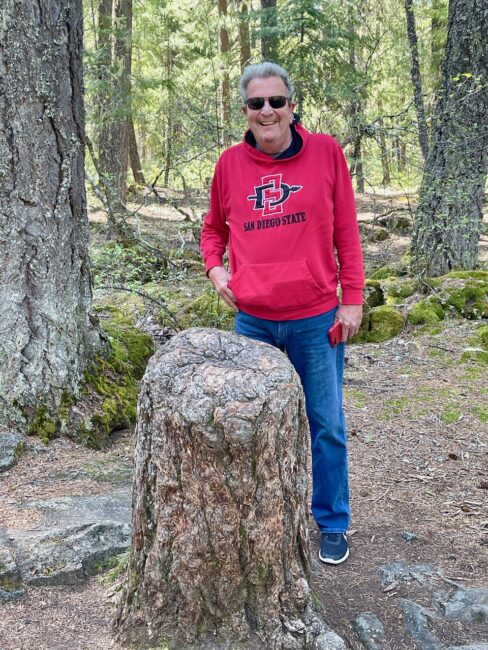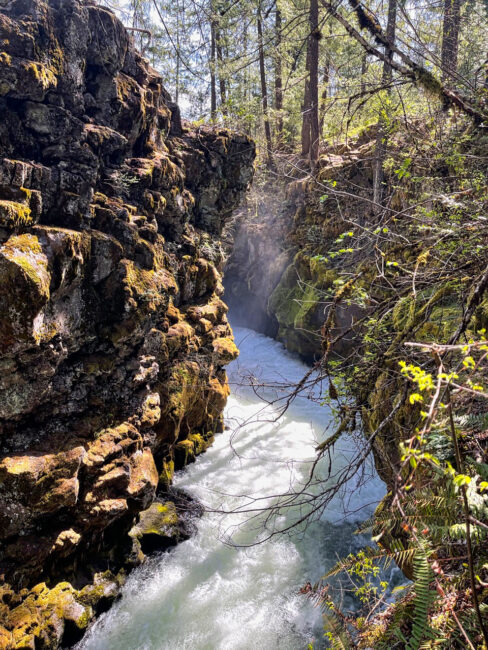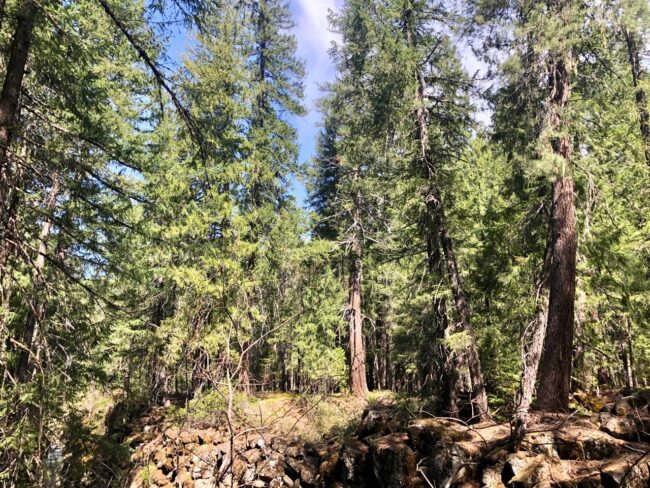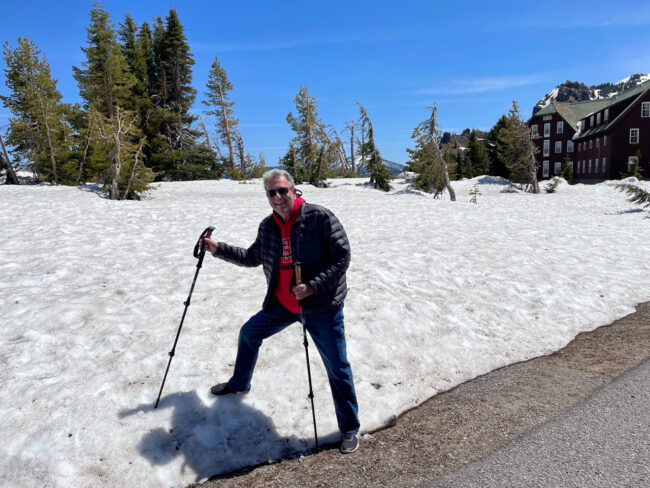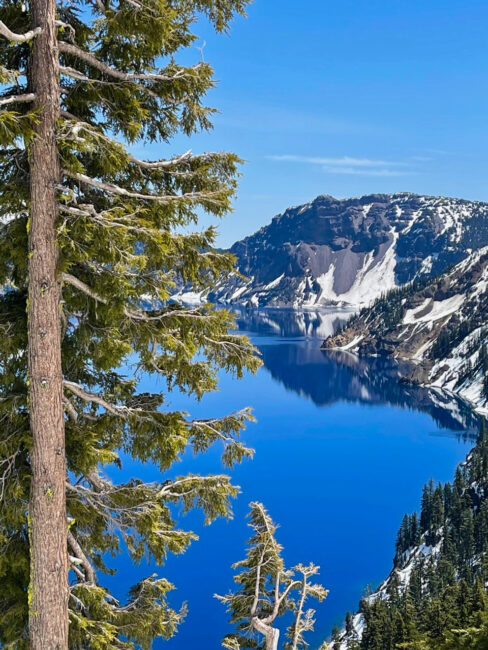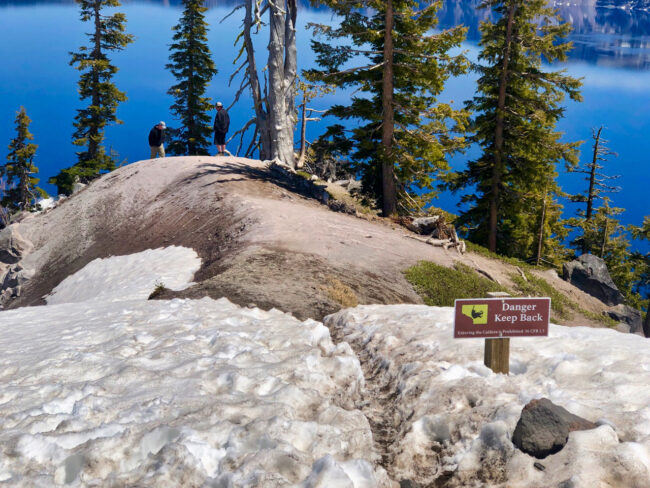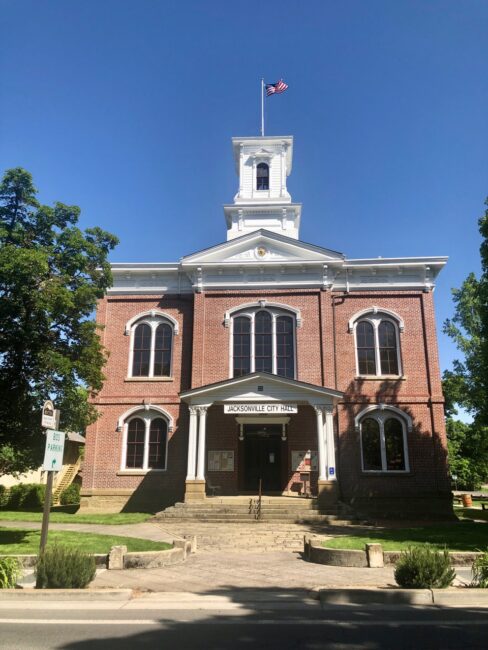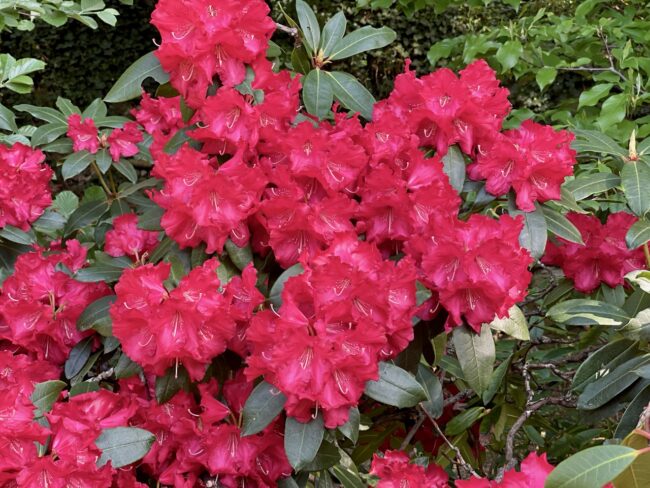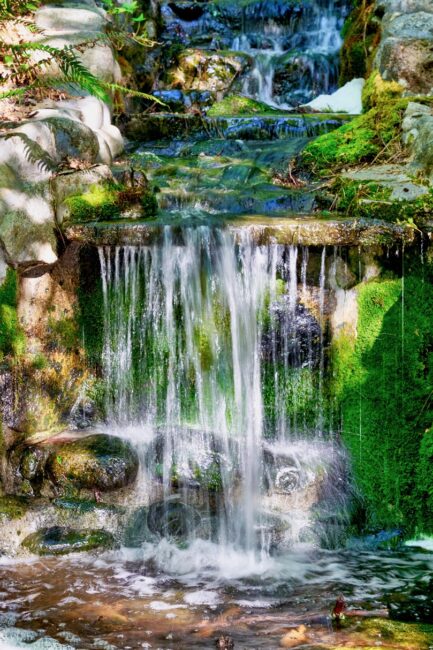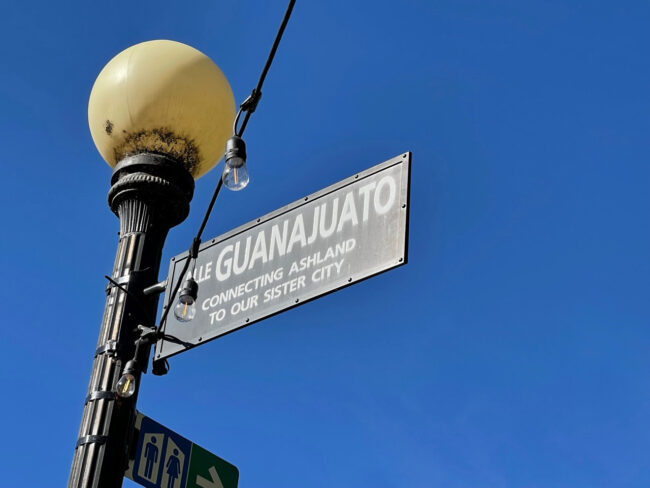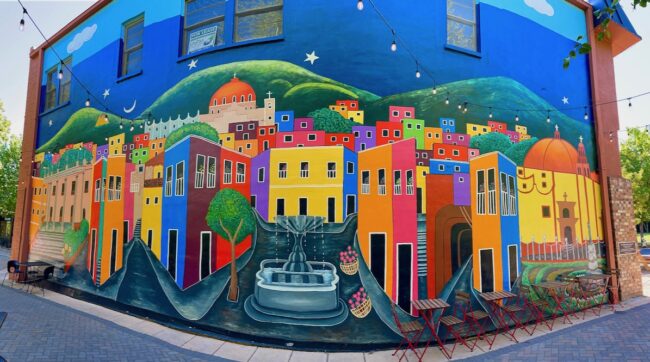
CHAPTER ONE: ASHLAND, HERE WE COME (WITH A SLIGHT DETOUR)
June 2, 2021
CHAPTER THREE: TWO DAYS IN MCMINNVILLE
June 14, 2021Post Vaccination Vacation: Mai Tai Tom’s Oregon Trail Tale
 CHAPTER TWO: CRATER LAKE/JACKSONVILLE/MORE ASHLAND
CHAPTER TWO: CRATER LAKE/JACKSONVILLE/MORE ASHLAND
Day Two: Fill ‘er up!, Going Rogue, The Magic Card, Seeing Blue, Did You Bring Your Skis, Mr. Wizard, A Frosty Reception, Ice Cream Truck, Are We In Florida, To Be Or Not To Be, Picturesque Park, Frank Lloyd Wright-Inspired and A Spicy Dinner Under The Bridge
After deciding upon our plan of attack for the day, the four of us climbed into the Marymobile (with Kim behind the wheel) for the 90-minute drive to Crater Lake National Park. Usually stopping at a gas station does not make for interesting fodder, but we were in for quite a surprise. As Kim exited the car to refuel, the gas station attendant ran up to tell him to get back in the car. We quickly learned that in Oregon, you can’t pump your own gas. It had been roughly 50 years since we had this kind of assistance, although the attendant didn’t wash the windshield (foreshadowing).
Usually stopping at a gas station does not make for interesting fodder, but we were in for quite a surprise. As Kim exited the car to refuel, the gas station attendant ran up to tell him to get back in the car. We quickly learned that in Oregon, you can’t pump your own gas. It had been roughly 50 years since we had this kind of assistance, although the attendant didn’t wash the windshield (foreshadowing).
Mai Tai Tom Fun Fact: The only other state you’re not allowed to pump your own gas is … New Jersey.
As we approached the entrance to Crater Lake National Park, there was a sign for a Viewpoint. Heeding our new manta of not passing these points of interest up, we drove to the Rogue River Gorge Viewpoint.
We spent the better part of a 45 minutes hiking the 1/4 mile paved loop trail alongside the Rogue River, which offered some cool views of the steep gorge. This was one swift river.
There is a longer hike (3 1/2 miles) with a trail that takes you to the Natural Bridge. However, the bridge we did see was wasn’t too shabby.
 We passed by The Living Stump. where I presumed I would have to make a speech. A sign stated, “Here on the flat surface of the lava flow, away from the Gorge wall, the trees live as a group rather than as individuals. The roots of these Douglas-firs have grown together, providing each other with nutrients and water. Before it was cut, the roots of this tree had grafted onto those of a neighbor. because of this, the stump continues to live.” Without this sign, I would have been stumped on how this came to be.
We passed by The Living Stump. where I presumed I would have to make a speech. A sign stated, “Here on the flat surface of the lava flow, away from the Gorge wall, the trees live as a group rather than as individuals. The roots of these Douglas-firs have grown together, providing each other with nutrients and water. Before it was cut, the roots of this tree had grafted onto those of a neighbor. because of this, the stump continues to live.” Without this sign, I would have been stumped on how this came to be.
On the opposite side of the river we could make out the Lava Tubes, where molten lava has drained out and left behind a hollow tube. I often ponder how they make those delicious chocolate cakes out of molten lava.
We learned that more than 7,000 years ago, Mt. Mazama (now Crater Lake), located 27 miles from here, exploded and sent “torrents of whitish pumice and ash down its flanks to the Rogue,” and the river changed course. Douglas firs abound in this area.
There are viewpoints along the loop trail that give exquisite views of the rushing water and small waterfalls.
Tracy thought it would be fun if I tried walking across the log above the river. Sadly, I had left my walking poles in the car.
 We even caught a little rainbow in one of the photos. We were virtually somewhere over the rainbow.
We even caught a little rainbow in one of the photos. We were virtually somewhere over the rainbow.
For some reason, one guy couldn’t figure out where the phone was located that was taking our photo.
 It was a relatively short drive to Crater Lake from the Rogue River Viewpoint, and as we reached a higher elevation, the temperature dropped significantly, and, what do you know, snow lined the side of the road.
It was a relatively short drive to Crater Lake from the Rogue River Viewpoint, and as we reached a higher elevation, the temperature dropped significantly, and, what do you know, snow lined the side of the road.
We entered from the West entrance (both the North entrance and Rim Road were still closed to traffic). As we approached the entrance, Tracy pulled out our National Park Senior Pass, a lifetime pass we purchased the last year senior lifetime passes were available for only $10 (they are now $80). The $10 pass we purchased before August 28, 2017, has been grandfathered (perfect word for it) in and is good for life. Showing the pass to the park ranger, he remarked, “Oh, you have the magic card,” and waved us through. Best ten bucks we’ve ever spent.
As we approached the entrance, Tracy pulled out our National Park Senior Pass, a lifetime pass we purchased the last year senior lifetime passes were available for only $10 (they are now $80). The $10 pass we purchased before August 28, 2017, has been grandfathered (perfect word for it) in and is good for life. Showing the pass to the park ranger, he remarked, “Oh, you have the magic card,” and waved us through. Best ten bucks we’ve ever spent. It was less than ten miles to The Rim Village, where we started shooting photos of this incredible lake that I last visited as a very young child.
It was less than ten miles to The Rim Village, where we started shooting photos of this incredible lake that I last visited as a very young child.
Our waiter weather forecaster’s prognostication from the evening before was right on the mark. The blue skies reflected upon and enhanced the deep blue of Crater Lake, which at 1,943 feet, is the deepest lake in the United States. It’s also one of the cleanest and clearest lakes in the world.
 Snow was all around us, which makes sense because Crater Lake’s average of 43 feet of snow per year makes it one of the snowiest spots in the U.S.
Snow was all around us, which makes sense because Crater Lake’s average of 43 feet of snow per year makes it one of the snowiest spots in the U.S. Kim chatted with a park ranger. She told him the lodge would tentatively reopen the following week. She also said to drive over to the Discovery Point parking area (a little more than a mile from the gift shop, for more spectacular views.
Kim chatted with a park ranger. She told him the lodge would tentatively reopen the following week. She also said to drive over to the Discovery Point parking area (a little more than a mile from the gift shop, for more spectacular views. Tracy took a photo of me “skiing” that she texted to my doctor as a joke. Actually, as you can see, I was really standing in the parking lot with my walking poles dug into the snow. She quickly sent him the follow-up, so he didn’t worry that he’d have a seriously injured old man on his hands.
Tracy took a photo of me “skiing” that she texted to my doctor as a joke. Actually, as you can see, I was really standing in the parking lot with my walking poles dug into the snow. She quickly sent him the follow-up, so he didn’t worry that he’d have a seriously injured old man on his hands.
The Discovery Point outlook provided an even better panorama of the lake and Wizard Island, which are the remains of the explosion of the once 12,000-foot volcano, Mt. Mazama, that erupted 7,700 years ago, forming Crater Lake.
It’s hard to believe many lakes in the world could have bluer water than Crater Lake. We attempted to notify these idiots’ next of kin on the way out. One misstep could mean instant oblivion.
We attempted to notify these idiots’ next of kin on the way out. One misstep could mean instant oblivion.
Hopefully, we’ll get a chance to return because the 33-mile Rim Road that includes 30 scenic pullouts sounds like one fantastic drive.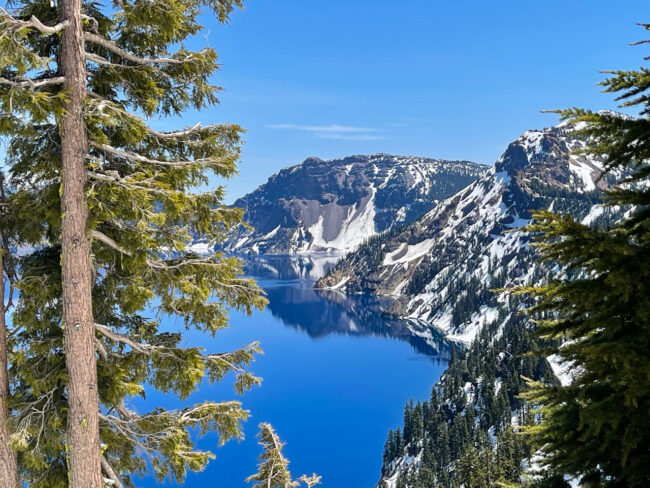 As we headed back toward civilization after our Crater Lake journey, we realized the hotel breakfast left us longing for a good meal. It was a little before 2 p.m. when we cruised into the town of Shady Cove, a name that Kim said implied, “a town where bodies are never seen again.” In reality, Shady Cove is a town people go to rent rafts for traveling on the Rogue River. It also has a surprisingly good fast food place we now highly recommend. Although a Mexican restaurant with a waterside patio beckoned us, Mary said, “Let’s try Phil’s Frosty,” whose sign read, “An Upper Rogue Landmark.” We thought, “Well, Phil has never lied to us before.”
As we headed back toward civilization after our Crater Lake journey, we realized the hotel breakfast left us longing for a good meal. It was a little before 2 p.m. when we cruised into the town of Shady Cove, a name that Kim said implied, “a town where bodies are never seen again.” In reality, Shady Cove is a town people go to rent rafts for traveling on the Rogue River. It also has a surprisingly good fast food place we now highly recommend. Although a Mexican restaurant with a waterside patio beckoned us, Mary said, “Let’s try Phil’s Frosty,” whose sign read, “An Upper Rogue Landmark.” We thought, “Well, Phil has never lied to us before.”
It seemed to be wildly popular. The parking lot of this drive-in was nearly full, and we found out why. Our Bacon burgers were reminiscent of the ones we used to get at A&W drive-ins (even more foreshadowing). Kim and Mary’s burgers were also devoured. Sorry, In-In-Out, Phil’s Frosty’s hamburgers win.
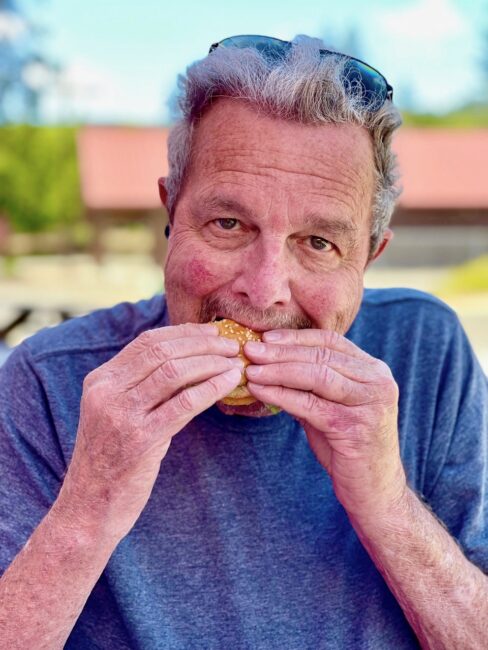 Since we hadn’t hit a church yet on this trip, I scurried over to Our Lady Of Fatima Catholic Church. Although falling short of what we hope to see at the Sanctuary of Our Lady of Fátima in Portugal later this year, it did posses a uniqeness about it.
Since we hadn’t hit a church yet on this trip, I scurried over to Our Lady Of Fatima Catholic Church. Although falling short of what we hope to see at the Sanctuary of Our Lady of Fátima in Portugal later this year, it did posses a uniqeness about it.
 Before departing we spied an odd sight, and, for once, it didn’t include one of us. An 18-wheeler suddenly stopped in the middle of the road. The driver jumped out of his rig, walked up to the order window and came away with a giant ice cream cone. Now, that must have been one damn good Umpqua ice cream cone to stop in the middle of the highway, and we were now sad we had ordered the french fries, because, although good, it left no room for ice cream.
Before departing we spied an odd sight, and, for once, it didn’t include one of us. An 18-wheeler suddenly stopped in the middle of the road. The driver jumped out of his rig, walked up to the order window and came away with a giant ice cream cone. Now, that must have been one damn good Umpqua ice cream cone to stop in the middle of the highway, and we were now sad we had ordered the french fries, because, although good, it left no room for ice cream.
 Kim asked what we wanted to do next, and Mary replied, “Let’s go to Jacksonville.” I thought the recent high altitude might have gone to her head, because we wouldn’t even have time to reach Atlanta, but she reminded me that the historic town of Jacksonville, Oregon, was less than an hour away.
Kim asked what we wanted to do next, and Mary replied, “Let’s go to Jacksonville.” I thought the recent high altitude might have gone to her head, because we wouldn’t even have time to reach Atlanta, but she reminded me that the historic town of Jacksonville, Oregon, was less than an hour away.
 Jacksonville takes “quaint” to another level. Tracy said it reminded her of towns in Gold Country in California, which made sense since Jacksonville is a historic Gold Rush town (gold was discovered here in 1851, and the town was founded a year later). Main Street seemed to be stuck back in another time. Budget Travel Magazine recently named Jacksonville “one of the ten coolest small towns” in the U.S.
Jacksonville takes “quaint” to another level. Tracy said it reminded her of towns in Gold Country in California, which made sense since Jacksonville is a historic Gold Rush town (gold was discovered here in 1851, and the town was founded a year later). Main Street seemed to be stuck back in another time. Budget Travel Magazine recently named Jacksonville “one of the ten coolest small towns” in the U.S.
 Mai Tai Tom Fun Fact: When Oregon became a state in 1859, Jacksonville became the largest inland trade center in the state.
Mai Tai Tom Fun Fact: When Oregon became a state in 1859, Jacksonville became the largest inland trade center in the state.
We wandered part of Jacksonville’s historic section, which was declared a U.S. National Historic Landmark in 1966. I asked Tracy if she’d drop me off at the J’Ville Tavern “Husband Day Care Center.” For more than 75 years, it has served as a spot where Jacksonville wives can dump their husbands off for a few hours and more than a few drinks.
This shop was a cut above.
 In front of the Bella Union Restaurant and Saloon, a plaque commemorates this historic building being utilized in the 1970 filming of the movie The Great Northfield Minnesota Raid.
In front of the Bella Union Restaurant and Saloon, a plaque commemorates this historic building being utilized in the 1970 filming of the movie The Great Northfield Minnesota Raid.
 A statue of Jacksonville Gold Miners stands in front of the town library. This guy was one deft pan handler.
A statue of Jacksonville Gold Miners stands in front of the town library. This guy was one deft pan handler. I wanted to try this contraption out only for the fact that inquisitiveness is one of my main character traits.
I wanted to try this contraption out only for the fact that inquisitiveness is one of my main character traits.
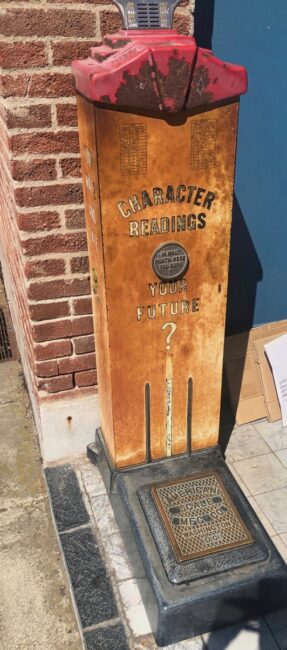 The United States Hotel dates from 1880, while the adjacent Jacksonville Inn, built in 1861, is now an award-winning B&B.
The United States Hotel dates from 1880, while the adjacent Jacksonville Inn, built in 1861, is now an award-winning B&B.
Main Street was lined with lots of restaurants and shops, while the side streets offered up some beautiful Victorian and Craftsmen homes. I think Tracy would move here just so she could garden. She even found a new friend.
Even the gift shops exude charm.
As we drove out of town, we made a couple of short detours. This buiding was the former Jackson County Courthouse, completed in 1884. It also housed the Jacksonville Museum, which closed 15 years ago due to lack of funding.
Our last quick stop took us to the historic Beekman House, an 1870s Gothic Revival house owned by wealthy banker Cornelius Beekman. The house, which provides tours in non-Covid times, was one of a string of houses that lined “Millionaires’ Row” in Jacksonville back in the 1880s.
We arrived back in Ashland about 4:30 p.m., and after both couples took a ten minute power nap (ah, just like the good old days of traveling), we hit the Ashland pavement … and grass.
In the years BC (Before Covid), between March and October, Ashland hosted the Oregon Shakespeare Festival, which features plays by the Bard, as well as other classic and contemporary playwrights, which certainly is not much ado about nothing. We stopped by the venue that I can only imagine on a warm July evening would make for a midsummer night’s dream. Should I come back to see one of them? That is the question.
As we headed for a stroll through Lithia Park, we spotted what looked like a bunch of water fountains in the Plaza. This unique landmark, the Lithia Water Fountain, was installed in 1927.
 According to sometimes correct, but never in doubt Wikipedia, “In 1907 a lithia water spring was discovered at Emigrant Creek several miles to the east. Upon analysis, the water was shown to have the second-highest concentration of (presumably beneficial) lithium in any natural spring (the highest being in the famous springs of Saratoga, New York). Although this water was once considered a health fad, it quickly fell out of favor because the water was rather disgusting tasting and some people equated the water’s pungent aroma to the smell of egg salad.”
According to sometimes correct, but never in doubt Wikipedia, “In 1907 a lithia water spring was discovered at Emigrant Creek several miles to the east. Upon analysis, the water was shown to have the second-highest concentration of (presumably beneficial) lithium in any natural spring (the highest being in the famous springs of Saratoga, New York). Although this water was once considered a health fad, it quickly fell out of favor because the water was rather disgusting tasting and some people equated the water’s pungent aroma to the smell of egg salad.” Nearby stood the Carter Memorial Fountain featuring “Pioneer Mike.” Mike has had an interesting history since he was put here in 1910. He was hit by a truck in 1931, and in 1973 Mike somehow fell, breaking a leg (probably needed my walking poles). Vandals broke Mike’s hand both in 2001 and 2014, but the old boy was rededicated once again in 2016. Although he’s had his share of limb trauma, Mike looks pretty darned good for a guy who is 111 years old.
Nearby stood the Carter Memorial Fountain featuring “Pioneer Mike.” Mike has had an interesting history since he was put here in 1910. He was hit by a truck in 1931, and in 1973 Mike somehow fell, breaking a leg (probably needed my walking poles). Vandals broke Mike’s hand both in 2001 and 2014, but the old boy was rededicated once again in 2016. Although he’s had his share of limb trauma, Mike looks pretty darned good for a guy who is 111 years old.
In just a minute, we found ourselves at he entrance to Lithia Park, “The Jewel of Ashland.” The 93-acre park includes a Japanese Garden, two duck ponds, a formal rose garden, playground, tennis courts and a plethora of plants, trees and flowers.
We walked in the various gardens for about an hour, and it truly is a spectacular park. Enjoying the creeks, path and expansive green areas, the four of us wandered in the midst of rhododendrons (man they grow big up here), lilacs, peonies and expansive green space.
Tracy loves the rhododendrons. Tracy said we were going to have to move to Ashland just to plant a bunch of these.
In 1914 the city of Ashland asked John McLaren to develop a landscape plan for the lower 18 acres of the park. McLaren was also the designer of San Francisco’s Golden Gate Park.
Interestingly, no dogs are allowed inside the park, which has been a point of contention for some of its citizens and visitors. Tracy loves the dogwoods, too (dogwoods are allowed). I guess I better find a realtor.
You’ll even find a little waterfall or two.
Adjacent to the park and across the street, we admired a Frank Lloyd Wright Prairie Style-inspired house. Though tempted, we didn’t ring the bell for a tour of this private residence. Tracy enjoyed the landscaping … while Kim and Mary loved the architectural structure.
We walked by a very happening area full of people enjoying outdoor dining and libations. Alongside the Ashland Creek on Calle Guanajuato (an alleyway that has a number of restaurants) stands a gorgeous mural.
“Las Calles de Guanajuato” is Ashland’s largest, and one of its most colorful, mural. The mural depicts Guanajuato, Mexico, which happens to be Ashland’s sister city.
We had 7 p.m. reservations for dinner a couple of blocks from here, and Tracy recalled she had seen the restaurant we were to dine at as we drove in from Jacksonville. She said we’d find it under a bridge. I thought she might be trolling me, but, as usual, Tracy was correct. (center photo below left from Taj Facebook page)
We were seated on the tree-shadowed, sort of creekside patio (sounds prettier than it was) of Taj Indian Cuisine restaurant, and yes it was located virtually under a bridge (as are a few other eateries here). The service was slow because it looked like they only had one server, but the food was worth the wait (and the weight gained).
 Tracy and I love spicy, and the dinner certainly lived up to that moniker. From the ChannaMasala Chickpeas (wow), and the Shrimp Vindaloo (Tracy) and Chicken Vindaloo (me), our sinuses were pretty much cleared out by the time we finished.
Tracy and I love spicy, and the dinner certainly lived up to that moniker. From the ChannaMasala Chickpeas (wow), and the Shrimp Vindaloo (Tracy) and Chicken Vindaloo (me), our sinuses were pretty much cleared out by the time we finished.
 Kim and Mary ordered their meals “medium spicy,” but they were both pretty hot, too.
Kim and Mary ordered their meals “medium spicy,” but they were both pretty hot, too. As for the garlic flavored bread … it was second to Naan.
As for the garlic flavored bread … it was second to Naan.
 With the spiciness of our meals, let’s just say, the Taj Mahal beer came in handy for all of us.
With the spiciness of our meals, let’s just say, the Taj Mahal beer came in handy for all of us.
 Walking back through charming Ashland, I told Tracy I believed this town could be our next home. Of course, this is about the 17th town I’ve said that about.
Walking back through charming Ashland, I told Tracy I believed this town could be our next home. Of course, this is about the 17th town I’ve said that about.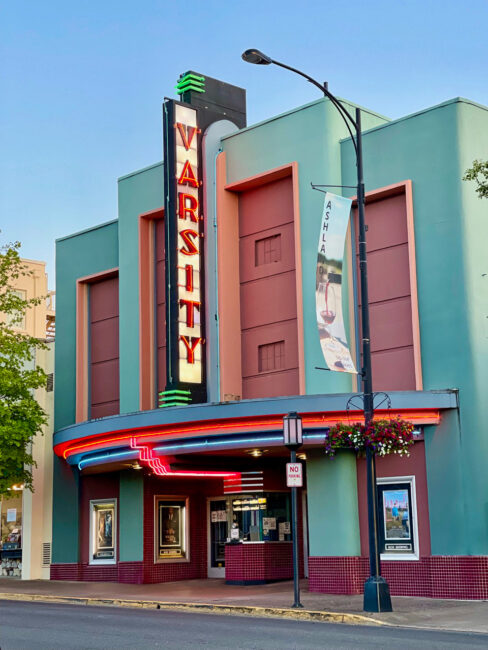
One more view courtesy of my friend The Internet. We’d pack up our two cars the following day for our nearly four-hour drive to McMinnville, a place many of our friends thought that Tracy and I would like to move to some day. It would be a mostly relaxing day, but also one where I would make another error in driving judgement. Hopefully, Tracy won’t take the keys from me before we finish the trip.
We’d pack up our two cars the following day for our nearly four-hour drive to McMinnville, a place many of our friends thought that Tracy and I would like to move to some day. It would be a mostly relaxing day, but also one where I would make another error in driving judgement. Hopefully, Tracy won’t take the keys from me before we finish the trip.
 While in McMinnville, we’d stay at a charming B&B, hit a winery or three, have two delectable dinners and we’d have to get “Spruced” up to hop aboard one of the world’s most famous airplanes. Of course, with this guy at the controls, disaster could happen at any moment.
While in McMinnville, we’d stay at a charming B&B, hit a winery or three, have two delectable dinners and we’d have to get “Spruced” up to hop aboard one of the world’s most famous airplanes. Of course, with this guy at the controls, disaster could happen at any moment.
NEXT – CHAPTER THREE: MCMINNVILLE
Days Three & Four: In The Mix, A Grave Find, Road Trips Are A Gas, Did You See A Shark, A Tuscan Affair, Against The Grain, Missed It By That Much, No … Not That “Q”, Wine Buying Begins, Dinner In A Pod, Why Didn’t I See This In Long Beach, Channeling Our Inner Howard Hughes, Da Planes! Da Planes!, Spaced Out, Cracklin’ Rosé, One Tasting Deserves Another & Dîner Dans Le Jardin






